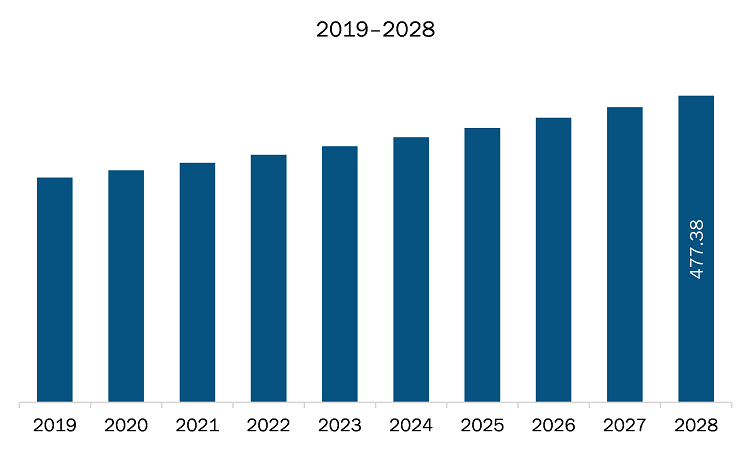The soluble dietary fibers market in South America is expected to grow from US$ 373.00 million in 2021 to US$ 477.38 million by 2028; it is estimated to grow at a CAGR of 3.6% from 2021 to 2028.
Soluble dietary fibers are used as an additive to foods, and they also promote the colonic health, along with bifidobacterial or lactobacillus stimulation in the gut, coronary artery health, lowers cholesterol, and glucose metabolism. Moreover, soluble dietary fibers contribute to weight management and reduce the risk of cardiovascular diseases. Water-soluble dietary fiber is considered as one of the significant forms of dietary fibers. It is composed of inulin, beta-glucan, polydextrose, pectin, fructooligosaccharides, galactooligosaccharides, and corn fiber, which helps promote the nutritional profile of the food and beverage product added. For instance, Roquette is involved in offering non-viscous soluble fiber under its brand “NUTRIOSE” for food, pharmaceutical and nutraceutical industries. NUTRIOSE is produced from cereals such as wheat and corn and provides efficient digestive tolerance. Similarly, Steadfast Nutrition, which is a premium sports and wellness nutrition company, is involved in offering soluble dietary fiber based dietary supplement powder under the brand, Tri Fiber. The presence of soluble dietary fiber helps maintain a healthy intestine, along with balanced blood glucose levels and serum lipids. Moreover, the product helps to manage the appetite hormones, enhances the bowel movement, and manages triglycerides levels in the body to improve the lipid profile by exercising a control over cholesterol levels. The improved effects of resistant maltodextrin are identified by Foods for Specified Health Use (FOSHU). The product can be consumed by office goers, weight watchers, athletes & fitness enthusiasts, and patients. Similarly, Benefiber and Metamucil are over the counter (OTC) soluble fiber supplements. Benefiber is approved by the Food and Drug Administration (FDA) as a dietary fiber supplement, and it is composed of wheat dextrin as an active ingredient. It helps to absorb water in the intestinal tract along with stimulating peristalsis or the repetitive contraction and relaxation of intestinal muscle. Metamucil is prepared from psyllium husks, obtained from seeds of an Indian herb, Plantago ovata. The growing focus on health, along with increasing consciousness toward health benefits offered soluble dietary fibers and increasing instances of chronic diseases, has motivated the manufacturers to produce nutraceutical and pharmaceutical products based upon soluble dietary fibers, which is expected to propel the demand for soluble dietary fibers market.
Brazil has been ranked to be the third-most affected economy due to COVID-19 pandemic globally. In South America, Brazil has the highest number of COVID-19 cases, followed by Ecuador, Chile, Peru, and Argentina, among others. The governments in South America have taken an array of actions to protect their citizens and combat the spread of COVID-19 virus through lockdowns, trade bans, and travel restrictions. This may have a direct impact upon the growth of the soluble dietary fibers market.
With the new features and technologies, vendors can attract new customers and expand their footprints in emerging markets. This factor is likely to drive the South America soluble dietary fibers market. The South America soluble dietary fibers market is expected to grow at a good CAGR during the forecast period.

- This FREE sample will include data analysis, ranging from market trends to estimates and forecasts.
South America Soluble Dietary Fibers Market Segmentation
South America Soluble Dietary Fibers Market – By Type
- Inulin
- Pectin
- Beta-glucan
- Polydextrose
- Others
South America Soluble Dietary Fibers Market – By Source
- Cereals and Grains
- Fruits and Vegetables
- Others
South America Soluble Dietary Fibers Market – By Application
- Food and Beverages
- Animal Nutrition
- Pharmaceuticals and Nutraceuticals
- Others
South America Soluble Dietary Fibers Market – By Country
- Brazil
- Argentina
- Rest of SAM
South America Soluble Dietary Fibers Market – Companies Mentioned
- Cargill, Incorporated
- Kerry Group
- Ingredion Incorporated
- Nexira
- Tate & Lyle PLC
- ADM
- IFF Nutrition & Biosciences
- BENEO GmbH
- Roquette Frères
South America Soluble Dietary Fibers Report Scope
| Report Attribute | Details |
|---|---|
| Market size in 2021 | US$ 373.00 Million |
| Market Size by 2028 | US$ 477.38 Million |
| CAGR (2021 - 2028) | 3.6% |
| Historical Data | 2019-2020 |
| Forecast period | 2022-2028 |
| Segments Covered |
By Type
|
| Regions and Countries Covered |
South and Central America
|
| Market leaders and key company profiles |
|
- Historical Analysis (2 Years), Base Year, Forecast (7 Years) with CAGR
- PEST and SWOT Analysis
- Market Size Value / Volume - Regional, Country
- Industry and Competitive Landscape
- Excel Dataset
Recent Reports
Testimonials
Reason to Buy
- Informed Decision-Making
- Understanding Market Dynamics
- Competitive Analysis
- Identifying Emerging Markets
- Customer Insights
- Market Forecasts
- Risk Mitigation
- Boosting Operational Efficiency
- Strategic Planning
- Investment Justification
- Tracking Industry Innovations
- Aligning with Regulatory Trends






















 Get Free Sample For
Get Free Sample For